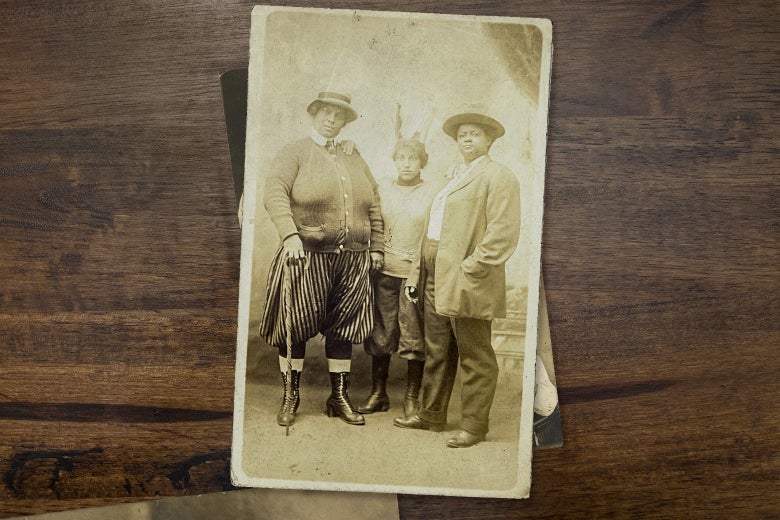
Photo illustrations by Slate. Photos by Smithsonian and Getty Images Plus.
My great-grandmother left behind a trove of family photographs dating back to the early 1900s when she passed away in 2012. A few in particular stand out: her grandparents and their 15-person family standing out front of a cabin; my grandfather, in a pair of jet-black shades, posing in the middle of a dirt road with a cigarette hanging out the left side of his mouth; my great-grandmother herself, in a scarf and an apron, regally looking back at an unknown photographer as she stands under the clothesline outside her shotgun house down in what they called Possum Alley.
I didn’t see the bulk of these images until after my great-grandmother died. She protected them hawkishly and most encounters I had with them beforehand were a result of me sneaking into her bedroom closet, tucking myself between the door and the bin where she housed them, to flip through albums. The hundreds of images, many of them portraits or snapshots of intimate family gatherings, are a record of my family’s history—one my uncle spent years attempting to digitize and archive on Facebook. It was a time-consuming process but photos catalogue life. They thread our past to our present, evoke nostalgia and allow us to better know ourselves and our legacy.
Such understanding is what prompted me to dig through the 2.8 million high-resolution images released into the public domain by the Smithsonian on Tuesday. I figured the Smithsonian would include images relevant to the Black experience in America due to the success of the National Museum of African-American History and Culture. An article about the images in Smithsonian Magazine noted that a portrait of Ida B. Wells would be made available. It was unlikely that the organization would only release a photo of her and no one else.
So that’s what I went searching for. I knew if I saw so much of myself within the medley of faces present in my great-grandmother’s photo albums, that I would likely see Blackness in the broader historical sense represented within the archives. What I found among the photos—which highlight pivotal Black publications, protest placards and anti-lynching campaign flyers—was an oeuvre of Black America’s history animated by Black womanhood.
Photo illustrations by Slate. Photos by Smithsonian and Getty Images Plus.
The archives present a kaleidoscope of the reality of Black womanhood: These women were musicians like jazz vocalist Maxine Sullivan; playwrights like Elizabeth Shearer White, known for her production of Othello featuring an all-Black cast; milliners like Mae Reeves; and athletes like golfer Ethel Funches. They registered voters, wrote letters to their loved ones and studied a variety of skills at the Manual Training and Industrial School for Colored Youth in Bordentown, New Jersey. Some joined Masonic societies, worked fields, sold pralines, and hit jigs at the Cotton Club.
Photo illustrations by Slate. Photos by Smithsonian and Getty Images Plus.
Photo illustrations by Slate. Photos by Smithsonian and Getty Images Plus.
I was struck by the enrollment certificate of a woman seeking attendance at Poro College, a cosmetics school dedicated to nurturing Black hair, and a formula for a hair growth serum. It reminded me of my own hair journey, particularly with straightening, and the larger, multifaceted nature of Black hair.
Photo illustrations by Slate. Photos by Smithsonian and Getty Images Plus.
But the portraits are what stood out the most. The regality and elegance captured in these photographs is not how Black women are often depicted publicly. Women dressed to the nines line up to attend a showing at a theatre. Another poses for a portrait in a polka-dotted dress while a third stands in a floor-length skirt and a fur stole hanging around her shoulders. A postcard of three women—one of whom is wearing an amazing pair of striped knickers and laced boots while sporting a cane—was most striking. Seeing Black women celebrated for their androgyny is breathtaking.
Photo illustrations by Slate. Photos by Smithsonian and Getty Images Plus.
Photo illustrations by Slate. Photos by Smithsonian and Getty Images Plus.
Photo illustrations by Slate. Photos by Smithsonian and Getty Images Plus.
It was refreshing to see these faces from the past, to find them looking me in the eye. They were a reminder that Black women have never been, nor do we have to be, one thing. These images were available for personal, educational, and non-commercial use before, but with Open Access, the institution’s copyright has been waived entirely. A large swath of knowledge of Black history is now in the public’s hands, for curious people to encounter without going through a museum, or their grandmothers.
They can go looking for themselves.
Readers like you make our work possible. Help us continue to provide the reporting, commentary and criticism you won’t find anywhere else.
Join Slate Plusfrom Slate Magazine https://ift.tt/393QpR7
via IFTTT
沒有留言:
張貼留言